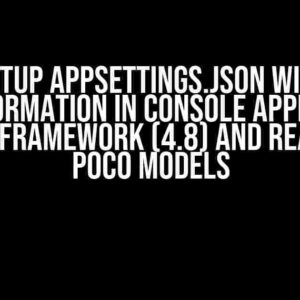Are you tired of seeing the frustrating error “MessageContract is Null” in your WCF endpoint? Do you struggle to bind your MessageContract to classes? You’re not alone! This article will take you on a journey to troubleshoot and resolve this common issue, providing clear and direct instructions to get your WCF service up and running smoothly.
Understanding WCF MessageContract
Before diving into the troubleshooting process, let’s take a quick refresher on WCF MessageContract. In WCF, a MessageContract is used to define the structure of a message that can be sent to or received from a service. It provides a way to specify the headers, body, and other elements of a message.
[MessageContract]
public class MyMessage
{
[MessageHeader]
public string Header1 { get; set; }
[MessageBodyMember]
public string Body { get; set; }
}In this example, the `MyMessage` class is decorated with the `MessageContract` attribute, which indicates that it defines a WCF message. The `Header1` property is marked with the `MessageHeader` attribute, specifying that it should be included in the message headers. The `Body` property is marked with the `MessageBodyMember` attribute, indicating that it should be included in the message body.
Common Causes of MessageContract not Binding to Classes
So, why does MessageContract not bind to classes? Here are some common causes:
- Missing or incorrect namespace: Make sure that the namespace of the MessageContract class matches the namespace of the service contract.
- Incorrect attribute usage: Verify that the correct attributes are used to decorate the properties and classes. For example, using `DataContract` instead of `MessageContract` can lead to binding issues.
- serialization issues: Ensure that the classes and properties are serializable and can be converted to XML or other formats used by WCF.
- Versioning issues: If you’re using versioning in your WCF service, ensure that the MessageContract version matches the service contract version.
- Invalid or missing configuration: Check the configuration files (e.g., web.config or app.config) to ensure that the WCF service is properly configured.
Troubleshooting Steps
Now that we’ve covered the common causes, let’s dive into the troubleshooting steps:
- Check the namespace and class names: Verify that the namespace and class names match exactly between the MessageContract class and the service contract.
- Verify attribute usage: Review the attributes used in the MessageContract class and ensure that they are correct and consistent with the service contract.
- Test serialization: Use tools like SoapUI or Fiddler to test the serialization of the MessageContract class and ensure it can be converted to XML or other formats used by WCF.
- Check versioning: If using versioning, ensure that the MessageContract version matches the service contract version.
- Review configuration files: Check the configuration files to ensure that the WCF service is properly configured and that the MessageContract is referenced correctly.
- Enable WCF tracing: Enable WCF tracing to get detailed logs of the service calls and any errors that may occur. This can help identify the root cause of the issue.
Resolution Steps
Once you’ve identified the cause of the issue, here are the resolution steps:
Step 1: Correct the Namespace and Class Names
Ensure that the namespace and class names match exactly between the MessageContract class and the service contract. Update the namespace and class names if necessary.
[MessageContract(Namespace="http://example.com/mynamespace")]
public class MyMessage { ... }Step 2: Verify Attribute Usage
Review the attributes used in the MessageContract class and ensure that they are correct and consistent with the service contract. Update the attributes if necessary.
[MessageContract]
public class MyMessage
{
[MessageHeader(Namespace="http://example.com/mynamespace")]
public string Header1 { get; set; }
[MessageBodyMember(Order=1)]
public string Body { get; set; }
}Step 3: Resolve Serialization Issues
If serialization issues are identified, ensure that the classes and properties are serializable and can be converted to XML or other formats used by WCF. Update the serialization settings or use a different serializer if necessary.
[DataContract(Namespace="http://example.com/mynamespace")]
public class MyMessage
{
[DataMember(Order=1)]
public string Header1 { get; set; }
[DataMember(Order=2)]
public string Body { get; set; }
}Step 4: Update Versioning (if necessary)
If using versioning, ensure that the MessageContract version matches the service contract version. Update the versioning settings if necessary.
[ServiceContract(Namespace="http://example.com/mynamespace", Version="1.0")]
public interface IMyService { ... }Step 5: Update Configuration Files
Review the configuration files to ensure that the WCF service is properly configured and that the MessageContract is referenced correctly. Update the configuration files if necessary.
<system.serviceModel>
<services>
<service name="MyService">
<endpoint address="" binding="basicHttpBinding" contract="IMyService">
<messageContract>
<messageContractType>MyMessage</messageContractType>
</messageContract>
</endpoint>
</service>
</services>
</system.serviceModel>Conclusion
In conclusion, troubleshooting and resolving the “MessageContract is Null” issue in WCF requires a thorough understanding of the MessageContract and its configuration. By following the steps outlined in this article, you should be able to identify and resolve the underlying cause of the issue, ensuring that your WCF service is up and running smoothly.
Additional Resources
For further reading and reference, here are some additional resources:
- WCF Message Contracts on Microsoft Docs
- WCF MessageContract vs DataContract on Stack Overflow
- Using Message Contracts in WCF on Pluralsight
By following the instructions and explanations provided in this article, you should be able to troubleshoot and resolve the “MessageContract is Null” issue in WCF, ensuring a smoother development experience and a more reliable WCF service.
Frequently Asked Question
Get answers to the most common questions about WCF MessageContract not binding to classes and MessageContract being Null in the endpoint.
Why is my MessageContract not binding to my class?
This can happen when the MessageContract attribute is not applied to the class or the class is not decorated with the DataContract attribute. Make sure to add the MessageContract attribute to the class and the DataContract attribute to the data members. Also, check if the namespace and name of the MessageContract match the ones defined in the service contract.
How do I troubleshoot a Null MessageContract in the endpoint?
To troubleshoot a Null MessageContract, enable tracing and message logging in your WCF service. This will help you identify the root cause of the issue. You can also use tools like Fiddler or WCF Test Client to inspect the SOAP messages and check if the MessageContract is being sent correctly. Additionally, verify that the service contract and operation contract are correctly defined and that the MessageContract is being returned in the response.
Can I use a MessageContract with a data contract?
Yes, you can use a MessageContract with a data contract. In fact, a MessageContract is often used to wrap a data contract. The MessageContract defines the SOAP headers and body, while the data contract defines the data structure. By combining both, you can create a robust and flexible service contract that can be easily serialized and deserialized.
Why is my MessageContract not being serialized correctly?
This can happen when the MessageContract is not decorated with the correct attributes or when the data members are not serialized correctly. Make sure to use the correct serialization attributes, such asDataMember, to specify how the data members should be serialized. Also, check if the data members are public and have a getter and setter. Additionally, verify that the serialization mode is set correctly in the service behavior.
Can I use a MessageContract with a custom message formatter?
Yes, you can use a MessageContract with a custom message formatter. A custom message formatter allows you to control how the message is serialized and deserialized. By using a custom message formatter with a MessageContract, you can create a custom serialization format that meets your specific requirements.



